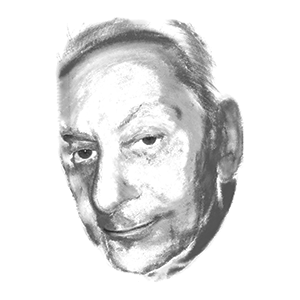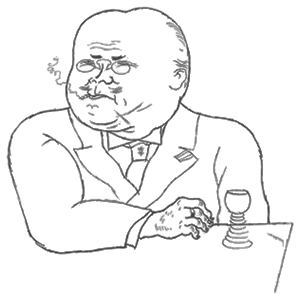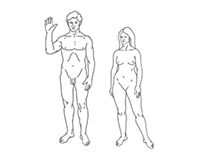Tobias Schneebaum (1922 – 2005) was an American artist, anthropologist, and AIDS activist. He is best known for his experiences living and traveling among the Harakmbut people of Peru, and the Asmat people of Papua, Indonesia.
Schneebaum was born into a family of Jewish emigres from Poland in New York City. Schneebaum’s father Jacob (known as Yankle) emigrated to America from Poland just before World War I, in which he served in order to get U.S. citizenship. His mother, Riftcha, emigrated in 1913. He was born as Toivele Schneebaum on Manhattan’s Lower East Side and grew up in Brooklyn. A school official later changed this to Theodore Schneebaum, by which he was known by friends and family throughout his childhood. (He later changed his name legally to Tobias.)
read more »
Tobias Schneebaum
Ever Meulen
Ever Meulen [myoo-lin] (born Eddy Vermeulen in 1946) is a Belgian illustrator, cartoonist, caricaturist and comic strip artist. His pseudonym is based on his name E. Vermeulen.
Vermeulen studied graphic arts at the Sint-Lucas School of Architecture in Ghent and Brussels. He debuted in 1970, working for the magazine ‘Humo,’ where he drew both comics (‘Balthazar de Groene Steenvreter’ (‘Balthasar the Green Stone Eater’) and ‘Piet Peuk’ (‘Pete Stub’)), as well as cover illustrations, caricatures and illustrations to articles. When ‘Humo’ published books or CDs, Meulen often provided the cover illustration.
read more »
Wassily Kandinsky
Wassily Kandinsky [kan-din-skee] (1866 – 1944) was a Russian painter, printmaker and art theorist. He was a major figure in modern art and painted some of the first modern abstract works. His art changed several times during his life. It was fauvist, abstract, expressionist and constructivist in turn.
He was interested in geometry in art and philosophy. The creative aspect of the form is expressed by a descending series of circles, triangles and squares. Kandinsky’s creation of abstract work followed a long period of development and maturation of intense thought based on his artistic experiences. He called this devotion to inner beauty, fervor of spirit, and spiritual desire inner necessity.
read more »
Charles and Ray Eames
Charles (1907–1978) and Ray Eames (1912–1988) were husband and wife American designers who made significant historical contributions to the development of modern architecture and furniture. Among their most well-known designs is the ‘Eames Lounge Chair.’ They also worked in the fields of industrial and graphic design, fine art, and film.
Charles was an American designer, architect and filmmaker. He and his second wife Ray Kaiser are responsible for groundbreaking contributions in the field of architecture, furniture design, industrial design, manufacturing and the photographic arts.
read more »
Steve Ditko
Steve Ditko (b. 1927) is an American comic book artist and writer best known as the artist and co-creator, with Stan Lee, of ‘Spider-Man’ and ‘Doctor Strange.’ As of mid-2012, Ditko continues to work at a studio in Manhattan’s Midtown West neighborhood. He has refused to give interviews or make public appearances since the 1960s, explaining in 1969 that, ‘When I do a job, it’s not my personality that I’m offering the readers but my artwork. It’s not what I’m like that counts; it’s what I did and how well it was done…. I produce a product, a comic art story. Steve Ditko is the brand name.’ He has, however, contributed numerous essays to Robin Snyder’s fanzine ‘The Comics.’
Ditko studied under ‘Batman’ artist Jerry Robinson in Manhattan at the Cartoonist and Illustrators School (later the School of Visual Arts). He began his professional career in 1953, working in the studio of Joe Simon and Jack Kirby, beginning as an inker and coming under the influence of artist Mort Meskin. During this time, he then began his long association with Charlton Comics, where he did work in the genres of science fiction, horror, and mystery. He also co-created the superhero ‘Captain Atom’ in 1960.
read more »
Susan Kare
Susan Kare (b. 1954) is an artist and graphic designer who created many of the interface elements for the Apple Macintosh in the 1980s. She left Apple with Steve Jobs in 1985 to be the Creative Director at his new company NeXT.
Kare was born in Ithaca, New York, and is the sister of noted aerospace engineer Jordin Kare. She graduated from Harriton High School in 1971, received her B.A., summa cum laude, in Art from Mount Holyoke College in 1975 and her Ph.D. from New York University in 1978. She next moved to San Francisco and worked for the Museum of Modern Art. Today, the MOMA store in New York City carries stationery and notebooks featuring her designs.
read more »
Anthony Ausgang
Anthony Charles Grant Thompson (b 1959), better known as Anthony Ausgang, is an LA based artist and writer born in Pointe-à-Pierre, Trinidad and Tobago. He is a principal painter associated with Lowbrow art, a populist movement with cultural roots in underground comix, punk music, and hot-rod culture. Ausgang was one of ‘the first major wave of lowbrow artists’ to show in Los Angeles in the early 1980s. The protagonists of his paintings are cats — ‘psychedelic, wide eyed, with a kind of evil look in their eyes.’
By 1993, his artistic production consisted of customized cars, original acrylic paintings, and commercial merchandise, including clothing, puzzles, toys, lighters, and posters. Laguna Art Museum commissioned Ausgang to design a hole for a miniature golf course exhibit at South Coast Plaza in 1996. In 2010, he did the cover art for the MGMT release ‘Congratulations,’ ‘an eye grabbing illustration that could easily been found on a Grateful dead release circa 1974.’
Florentijn Hofman
Florentijn Hofman (b. 1977) is a Dutch artist known for playful urban installations such as the ‘Rubber Duck’ (a giant floating sculpture). They were built in various sizes, including one created in 2007 that is the largest rubber duck in the world at 105 feet long. Hofman’s tour was named ‘Spreading joy around the world.’ He aimed to recall everyone’s childhood memories by exhibiting the duck in 14 cities. The ducks are constructed with more than 200 pieces of PVC. There is an opening at the back of the body so that staff can perform maintenance. In addition, there is an electric fan in its body so that it can be inflated at any time, in either good or bad weather.
Since 2007, the ducks have been on display in Amsterdam, Belgium, Osaka, Sydney, Sao Paulo, Hong Kong, and Pittsburg. In 2009, while it was on display in Belgium, vandals stabbed the duck 42 times. The duck on display in Hong Kong was damaged and deflated in Taiwan after an earthquake, before bursting a few weeks later. In 2013, Sina Weibo, China’s most popular microblog, blocked the terms ‘Big Yellow Duck.’ The censorship occurred because a photoshopped version of ‘Tank Man’ (the Tiananmen Square protester), which swapped all tanks with this sculpture, had been circulating.
Bill Watterson
Bill Watterson (b. 1958) is an American artist and the author of the comic strip ‘Calvin and Hobbes,’ which was syndicated from 1985 to 1995. Watterson stopped drawing the strip at the end of 1995 with a short statement to newspaper editors and his readers that he felt he had achieved all he could in the medium.
Watterson is known for his views on licensing (he refused to merchandise his creations on the grounds that displaying their images on commercially sold mugs, stickers and T-shirts would devalue the characters and their personalities) and his move back into private life after ‘Calvin and Hobbes.’
read more »
Kehinde Wiley
Kehinde [keh-hin-day] Wiley (b. 1977) is a New York-based portrait painter, who is known for his highly naturalistic paintings of people with black and brown skin in heroic poses. His portraits are based on photographs of young men who Wiley sees on the street. He painted men from Harlem’s 125th Street, then South Central neighborhood where he was born.
Dressed in street clothes, his models were asked to assume poses from the paintings of Renaissance masters, such as Tiziano Vecellio and Giovanni Battista Tiepolo. The artist describes his approach as ‘interrogating the notion of the master painter, at once critical and complicit.’ His figurative paintings ‘quote historical sources and position young black men within that field of power.’
read more »
George Grosz
George Grosz [grohs] (1893 – 1959) was a German artist known especially for his caricatural drawings of Berlin life in the 1920s. He was a prominent member of the Berlin Dada and New Objectivity group during the Weimar Republic before he emigrated to the United States in 1933.
According to art critic Robert Hughes: ‘In Grosz’s Germany, everything and everybody is for sale. All human transactions, except for the class solidarity of the workers, are poisoned. The world is owned by four breeds of pig: the capitalist, the officer, the priest and the hooker, whose other form is the sociable wife. He was one of the hanging judges of art.’
read more »














